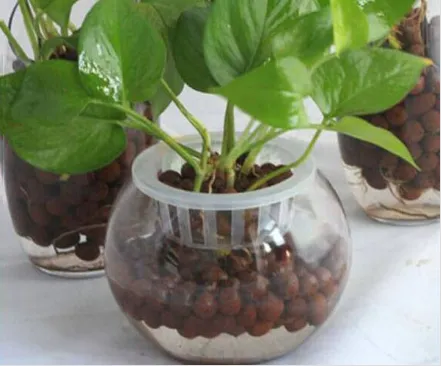Hydroponic Clay Pebbles: An ideal matrix that balances stability and breathability
Hydroponic technology, as a new type of planting method that does not require soil, has received increasing attention in recent years. It provides plants with the necessary nutrients for growth directly through nutrient solutions, demonstrating unique advantages in space utilization, yield control, and pest management. Among numerous hydroponic substrates, Hydroponic Clay Pebbles have become a widely used and highly respected choice due to their unique physical and chemical properties.

Hydronic Clay Pebbles are lightweight porous particles formed by high-temperature calcination of clay
This unique structure endows it with excellent physical properties, making it an ideal hydroponic substrate. Firstly, hydroponic clay balls have good breathability. The porous surface and gaps between particles ensure that plant roots can fully access oxygen, avoiding decay caused by hypoxia. This breathability is crucial for the healthy growth of plants, especially in hydroponic environments where roots are immersed in nutrient solutions for a long time and require sufficient oxygen supply.
Hydronic Clay Pebbles have excellent water retention properties
The porous structure inside hydroton clay pellets can store a certain amount of water and nutrients. In the event of delayed or interrupted nutrient circulation, it can provide buffering for plants and prevent damage due to water or nutrient deficiency. This water retention performance improves the stability of hydroponic systems to a certain extent and reduces planting risks.
In addition, clay growing media has stable chemical properties, is inert, does not react chemically with nutrient solution, and does not release harmful substances, thus ensuring the purity and stability of nutrient solution. This is crucial for precise control of nutrient solution formulations to meet the specific nutrient needs of plants. At the same time, Hydronic Clay Pebbles themselves are not easily decomposed, have a long service life, and have good economic benefits.
Hydronic Clay Pebbles also have certain limitations
Due to its lack of any nutrients, it relies entirely on the supply of nutrient solution. This means higher requirements for the management of nutrient solutions, requiring regular monitoring and adjustment of the concentration and pH value of nutrient solutions. In addition, the particle size and shape of hydroponic expanded balls may not be uniform enough, which may affect the distribution and growth of roots in some cases.
In summary, Hydroponic Clay Pebbles, as a hydroponic substrate, has significant advantages such as good air permeability, good water retention, and stable chemical properties. It can provide a good growth environment for plant roots, improve the stability and yield of hydroponic systems. Although there are certain limitations, through scientific management and improvement, its advantages can be fully utilized, its shortcomings can be overcome, and it can play a greater role in the field of hydroponics, contributing to the development of modern agriculture.
Hydroponic Clay Pebbles FAQs
What is Hydronic Clay Pebbles?
Hydronic Clay Pebbles are porous clay particles that have been fired at high temperatures, typically with a diameter of 816mm. They have a stable physical structure, good breathability, and water retention, making them one of the most commonly used growth media in hydroponics and soilless cultivation. Hydronic Clay Pebbles are circular or elliptical in shape, often reddish brown in color.
What are the main features of Hydronic Clay Pebbles?
The main features include:
Excellent breathability and drainage
Neutral pH value (6.57.5), will not affect the balance of nutrient solution
Reusable, can be reused multiple times after disinfection
Aseptic and insect free, reducing the risk of pests and diseases
Good water and fertilizer retention ability
Stable physical structure that will not decompose or decay
What plants are suitable for planting Hydronic Clay Pebbles?
Specially suitable for planting:
Leafy vegetables: lettuce, spinach, coriander, etc
Solanaceous fruits: tomatoes, peppers, eggplants, etc
Herbal plants: mint, basil, rosemary, etc
Ornamental plants: green ivy, turtle backed bamboo, orchids, etc
Strawberry and other berry plants
What are the precautions when using Hydronic Clay Pebbles?
Attention should be paid when using:
Before the first use, it is necessary to thoroughly rinse and remove dust
Regularly check the pH value to avoid salt accumulation
Thoroughly disinfect during recycling (can be treated with boiling water or hydrogen peroxide)
Use in conjunction with appropriate nutrient solution
Regularly check the health status of the root system
Avoid direct sunlight to prevent algae growth
What are the advantages of Hydronic Clay Pebbles compared to other media?
The main advantages include:
More environmentally friendly and reusable than rock wool
More durable than coconut coir and less prone to decomposition
Better water retention than perlite
More breathable than vermiculite
Lighter and more nutritious than ordinary stones
More cost-effective than moss
-
The Versatile World of Phlogopite Mica: Properties, Forms, and Applicationsਖ਼ਬਰਾਂJul.14,2025
-
The Versatile Applications of Calcined Mica: From Decoration to Industrial Useਖ਼ਬਰਾਂJul.14,2025
-
The Role of Muscovite Mica in Industrial Insulation Materialsਖ਼ਬਰਾਂJul.14,2025
-
The Benefits of Using Expanded Clay Pebbles in Hydroponics and Soil Gardeningਖ਼ਬਰਾਂJul.14,2025
-
Innovative Applications of Mica Flake in Paints and Coatingsਖ਼ਬਰਾਂJul.14,2025
-
Gardening Expanded Clay Usage: A Complete Guideਖ਼ਬਰਾਂJul.14,2025
-
The Use of Natural Mica Powder in Skincare Productsਖ਼ਬਰਾਂJun.11,2025








